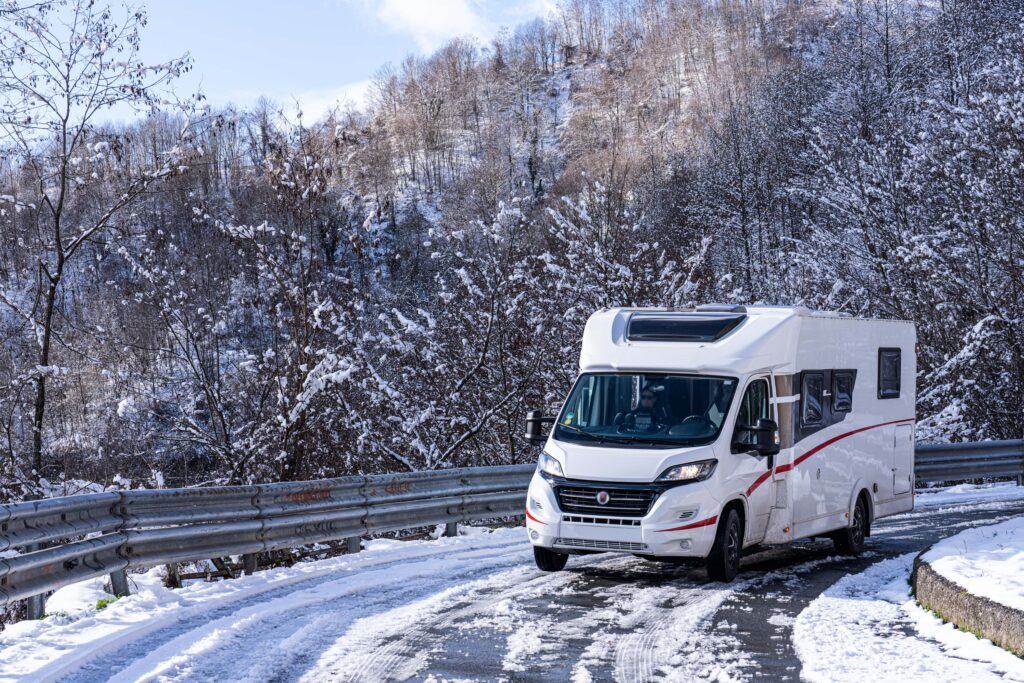How to Prepare Your Motorhome for the Coldest Season – A Guide to Winterisation
4 minutes well spent

There’s a chance that you might still be out and about, but during the colder months of the year (i.e. winter and a few weeks either side of it), most people are not likely to use their motorhome. You’re likely to park it up or put it into storage for an extended period of time. In this edition of our blog, we’ll explore winterisation – that is, give you a list of the things you need to think about to ensure your motorhome stays safe, sound and in the best condition while it’s parked or stored, ready for the start of the next holiday season.
What’s so important about winterisation?
There’s a lot of moisture in the air during the winter, so motorhomes are particularly vulnerable to dampness during this time of year. Dampness can lead to mould and, if it’s severe enough, can even go so far as to compromise the structural integrity of your vehicle. Despite ongoing improvements in the build quality of new motorhomes, damp and condensation can’t be completely wiped out (if you’ll excuse the pun) as they are natural concerns, and therefore they need careful management. There are ways to protect the interior and exterior of your motorhome, through winterisation.
Winterising the exterior of your Motorhome
- Cleaning: Residue left on the exterior of a vehicle over winter (in short: dust, tree sap and bird poo) can harden, stain and damage the paintwork – as well as making it much harder to clean when the vehicle is ready to use again after winter. Begin the process of winterisation by thoroughly cleaning the exterior – not just the body work but also the awning (if there is one), the wheels, wheel wells, windows and door seals. If the motorhome is going to be left uncovered, think about applying a wax polish as this can give extra protection against UV rays, dirt and grime.
- Storage: Choose a suitable spot to park or store the motorhome so that you avoid exposure to tree sap, bird mess, moss, and mildew. For added protection, cover the motorhome with a fitted cover if possible – but avoid tarpaulins, as they can actually trap moisture and scratch the surface of the bodywork.
- Seals and vents: To prevent degrading over winter, you should apply a light smear of silicone grease to the rubber seals on windows, doors and fittings. Be really careful that you avoid petroleum-based products as these can actually corrode rubber, which might lead to further damage.
- Tyres: Long periods with the motorhome in one position can lead to tyres developing flat spots. This will result in a bumpy ride when it’s back on the road. Use levelling equipment to lift some of the weight off the tyres or, if that’s not possible, move the motorhome forwards or backwards periodically, to shift the weight onto a different part of the tyres. Cold temperatures and UV exposure (sunlight) can also degrade tyres – so consider the idea of using wheel covers to protect them.
Winterising the interior of your Motorhome
- Water: Since water freezes in winter, it’s really important to ‘drain down’ all systems to prevent burst pipes and damage. After you’ve cleaned your tanks and pipework, fully drain and leave the system vented, as this will allow any moisture that remains to expand safely. Be sure you drain the shower, empty the toilet cassette and unplug any drains. If your motorhome has a wet heating system, fill it with the appropriate antifreeze according to guidelines in the manufacture’s manual.
- Gas: To prevent potential leaks or hazards, gas bottles should be isolated during periods that the motorhome is parked up or in storage for the winter.
- Cleaning: Wipe down all surfaces (tables, kitchen worktop, bathroom walls etc), and make sure that they’re as dry as possible. Empty the fridge, remove all food items from it (and also from cupboards) and hoover up thoroughly to get rid of crumbs and food particles that could attract insects or even rodents. Once you’ve cleaned it out, leave the fridge door ajar (for airflow) and open all of the cupboards and lockers as this will enhance ventilation. Remove any cushions and bedding (including the mattress if possible), as they trap moisture and lead to a musty smell.
- Appliances: Take out any removable items (TVs, kettles and other small electronics), as they may be damaged by damp or cold. If possible, store them in a warmer, dry location (i.e. your house). You should also remove batteries from devices like remote controls, as they may leak if they’re left over winter.
Additional tips for winterisation
Investing in a good-quality moisture meter provides you with a valuable tool during winter storage. It will help you monitor damp levels and spot potential moisture problems, and therefore give you an early heads up that you need to address something. Checking on a regular basis for moisture can prevent mould, mildew and other related issues before they become severe and damaging for your motorhome. Check out the Don Amott Accessory Store for this and other useful motorhome accessories.
Taking the winterisation steps we’ve described in this edition of the Don Amott blog can significantly help protect your motorhome or campervan during storage. Keeping it in optimal condition throughout the winter will not only improve your experience but also preserve the vehicle’s value for years to come.
We’ve got 100s of new and used stock for you to discover


